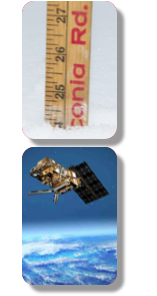
|

|


Measuring weather
 An integral part of understanding what weather is and recognizing various
weather features, like cold fronts and monsoons, is the act of measuring the
weather. Measuring weather is accomplished using a number of different tools
of wide-ranging complexity, from rulers to satellites.
Making measurements, or observations, of the weather helps us determine if it is
hot or cold, wet or dry, windy or calm, sunny or cloudy, and even what kinds of
unusual chemicals might be floating about. It is a very important act that is
practiced by amateurs and professionals alike, with varying degrees of accuracy
and precision that have generally improved throughout the history of weather
observations.
The results of weather observations have many applications, including directing
a group of friends to eat indoors or out, determining whether an airplane should
take off, initializing a weather forecast, or becoming the basic building block
for compiling a record of climatology.
At it's simplest, there are two types of weather measurements:
An integral part of understanding what weather is and recognizing various
weather features, like cold fronts and monsoons, is the act of measuring the
weather. Measuring weather is accomplished using a number of different tools
of wide-ranging complexity, from rulers to satellites.
Making measurements, or observations, of the weather helps us determine if it is
hot or cold, wet or dry, windy or calm, sunny or cloudy, and even what kinds of
unusual chemicals might be floating about. It is a very important act that is
practiced by amateurs and professionals alike, with varying degrees of accuracy
and precision that have generally improved throughout the history of weather
observations.
The results of weather observations have many applications, including directing
a group of friends to eat indoors or out, determining whether an airplane should
take off, initializing a weather forecast, or becoming the basic building block
for compiling a record of climatology.
At it's simplest, there are two types of weather measurements:
Next page -> measuring weather, continued
Links and resources
 An integral part of understanding what weather is and recognizing various
weather features, like cold fronts and monsoons, is the act of measuring the
weather. Measuring weather is accomplished using a number of different tools
of wide-ranging complexity, from rulers to satellites.
Making measurements, or observations, of the weather helps us determine if it is
hot or cold, wet or dry, windy or calm, sunny or cloudy, and even what kinds of
unusual chemicals might be floating about. It is a very important act that is
practiced by amateurs and professionals alike, with varying degrees of accuracy
and precision that have generally improved throughout the history of weather
observations.
The results of weather observations have many applications, including directing
a group of friends to eat indoors or out, determining whether an airplane should
take off, initializing a weather forecast, or becoming the basic building block
for compiling a record of climatology.
At it's simplest, there are two types of weather measurements:
An integral part of understanding what weather is and recognizing various
weather features, like cold fronts and monsoons, is the act of measuring the
weather. Measuring weather is accomplished using a number of different tools
of wide-ranging complexity, from rulers to satellites.
Making measurements, or observations, of the weather helps us determine if it is
hot or cold, wet or dry, windy or calm, sunny or cloudy, and even what kinds of
unusual chemicals might be floating about. It is a very important act that is
practiced by amateurs and professionals alike, with varying degrees of accuracy
and precision that have generally improved throughout the history of weather
observations.
The results of weather observations have many applications, including directing
a group of friends to eat indoors or out, determining whether an airplane should
take off, initializing a weather forecast, or becoming the basic building block
for compiling a record of climatology.
At it's simplest, there are two types of weather measurements:- in situ - measurements taken from within the air sample being measured
- remote - measurements taken from outside the air sample being measured
Next page -> measuring weather, continued
Links and resources
